Electricity
NCERT--CBSE-Class-10-Science-Chapter-11
Solutions
Question 1. What does an electric circuit mean?
A continuous and closed path along which an electric current flow is called an electric circuit.
Question 2. Define the unit of current.
If one coulomb of charge flows through any section of a conductor in one second, then current through it is said to be one ampere.
1 A = 1 Cs-1
Question 3. Calculate the number of electrons constituting one coulomb of charge.
Charge on one electron, e = 1.6 x 10-19 C
Total charge, Q = 1 C
Number of electrons, n = \(\frac{Q}{e}\) = \(\frac{1}{1.6×10^{-19}}\) = 6.25 x 1018 electrons.
In−text Solutions (Page 174)
Question 1. Name a device that helps to maintain a potential difference across a conductor.
Electric cell or battery is a device that helps to maintain a potential difference across a conductor.
Question 2. What is meant by saying that the potential difference between two points is 1 V?
The potential difference between two points is 1 volt if one joule of work is done in moving a positive charge of one coulomb from one point to the other point.
Question 3. How much energy is given to each coulomb of charge passing through a 6 V battery?
Energy given by battery = Charge x Potential difference = 1 C x 6 V = 6 J.
In−text Solutions (Page 181)
Question 1. On what factors does the resistance of a conductor depend?
The resistance of a conductor depends
- on its length,
- on its area of cross-section,
- its temperature
- on the nature of its material.
Question 2. Will current flow more easily through a thick wire or a thin wire of the same material, when connected to the same source? Why?
- The current will flow more easily through a thick wire than a thin wire of the same material.
- Larger the area of cross-section of a conductor, more is the ease with which the electrons can move through the conductor. Hence smaller is the resistance of the conductor.
Question 3. Let the resistance of an electrical component remains constant while the potential difference across the two ends of the component decreases to half of its former value. What change will occur in the current through it?
When potential difference is halved, the current through the component also decreases to half of its initial value. This is in accordance with Ohm's law i.e., V ∝ I.
Question 4. Why are coils of electric toasters and electric irons made of an alloy rather than a pure metal?
The coils of electric toasters and electric irons are made of alloys instead of pure metal due to the following reasons:
- Alloys have higher resistivity than that of their constituent metals.
- Alloys do not oxidise (or burn) readily at high temperatures.
Question 5. Use the data in Table 11.2 to answer the following –

(a) Which among iron and mercury is a better conductor?
(b) Which material is the best conductor?
(a) Resistivity of iron = 10.0 x 10-8 Ω m, Resistivity of mercury = 94.0 x 10-8 Ω m
Thus, iron is a better conductor because it has lower resistivity than mercury.
(b) As silver has the lowest resistivity (= 1.60 x 10-8 Ω m), so silver is the best conductor.
In−text Solutions (Page 185)
Question 1. Draw a schematic diagram of a circuit consisting of a battery of three cells of 2 V each, a 5 W resistor, an 8 W resistor, and a 12 W resistor, and a plug key, all connected in series.
The required circuit diagram is given below:

Question 2. Redraw the circuit of Question 1, putting in an ammeter to measure the current through the resistors and a voltmeter to measure the potential difference across the 12 W resistor. What would be the readings in the ammeter and the voltmeter?
The required circuit diagram is given below:

Equivalent resistance of the circuit,
R = R1 + R2 + R3 = 5 + 8 + 12 = 25 Ω …[R1, R2 and R3 are connected in series]
In series combination, current flowing through all the resistances is same and equal to the total current flowing through the circuit.
∴ Current in each resistors, I = V/R = 6/25 = 0.24 A
∴ Ammeter reading = 0.24 A
Potential across 12 Ω resistance,
V= IR = 0.24 ×12 = 2.88V
∴ Voltmeter reading is 2.88 V.
In−text Solutions (Page 188)
Question 1. Judge the equivalent resistance when the following are connected in parallel – (a) 1 Ω and 106 Ω, (b) 1 Ω and 103 Ω, and 106 Ω.
When resistors are connected in parallel, then the equivalent resistance is less than the least resistance connected in the combination. In both (a) and (b) cases, the equivalent resistance is less than 1 Ω but is approximately 1 Ω.
Question 2. An electric lamp of 100 Ω, a toaster of resistance 50 Ω, and a water filter of resistance 500 Ω are connected in parallel to a 220 V source. What is the resistance of an electric iron connected to the same source that takes as much current as all three appliances, and what is the current through it?
Let the resistance of lamp, R1 = 100 Ω
Resistance of toaster, R2 = 50 Ω
Resistance of filter, R3 = 500 Ω
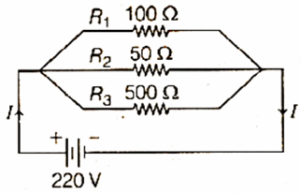
Net resistance, \(\frac{1}{R}=\frac{1}{R_1}+\frac{1}{R_2}+\frac{1}{R_3}\) = \(\frac{1}{100}+\frac{1}{50}+\frac{1}{500}\) = \(\frac{16}{500}\)
∴ R = \(\frac{500}{16}\) = 31.25 Ω
So, resistance of iron to take same current as much current drawn by all the appliances should be 31.25 Ω.
Current through circuit, I = \(\frac{V}{R}\) = \(\frac{220}{31.25}\) = 7.04 A
Thus, current through iron is 7.04 A.
Question 3. What are the advantages of connecting electrical devices in parallel with the battery instead of connecting them in series?
Following are the advantages of connecting electrical devices in parallel with the battery
- Parallel circuit divides the current among the electrical devices, so that they can have necessary amount of current to operate properly.
- If one of the devices in a parallel combination fuses or fails, then the other devices keep working without being affected.
Question 4. How can three resistors of resistances 2 Ω, 3 Ω, and 6 Ω be connected to give a total resistance of (a) 4 Ω, (b) 1 Ω?
(i) If 3 Ω and 6 Ω are connected in parallel, thus equivalent resistance of parallel combination = \(\frac{1}{1/3+1/6}\) = \(\frac{6}{3}\) = 2 Ω
If this combination is connected in series with 2 Ω resistance, then total equivalent resistance R = 2 Ω + 2 Ω = 4 Ω.
The resistor connections are as shown below
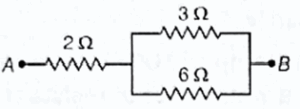
(ii) Since, equivalent resistance is less than the least value of resistance (i.e. 2 Ω), it means that all three resistors are connected in parallel.

R = \(\frac{1}{1/2+1/3+1/6}\) = 1 Ω
Question 5. What is (a) the highest, (b) the lowest total resistance that can be secured by combinations of four coils of resistance 4 Ω, 8 Ω, 12 Ω, 24 Ω?
(i) Resistance is maximum when resistors are connected in series.

Rmax = 4 + 8 + 12 + 24 = 48 Ω
(ii) Resistance is minimum when resistors are connected in parallel.
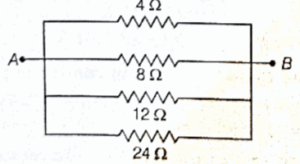
Rmin = \(1/[\frac{1}{4}+\frac{1}{8}+\frac{1}{12}+\frac{1}{24}]\) = \(1/[\frac{12}{24}]\) = \(\frac{24}{12}\) = 2 Ω
In−text Solutions (Page 190)
Question 1. Why does the cord of an electric heater not glow while the heating element does?
The cord of an electric heater has lesser resistance than its heating element, so more heat is produced in the heating element than the cord and it glows.
Question 2. Compute the heat generated while transferring 96000 coulomb of charge in one hour through a potential difference of 50 V.
Here, Q = 96,000 C, t = 1 hour = 3600 s, V = 50 V
Heat generated, H = VQ = 50 V x 96,000 C = 48,00,000 J = 4800 kJ.
Question 3. An electric iron of resistance 20 W takes a current of 5 A. Calculate the heat developed in 30 s.
Here, R = 20 Ω, I = 5 A, t = 30 s
Heat developed is H = I2Rt = 52 x 20 x 30 = 25 x 600 = 15,000 J.
In−text Solutions (Page 192)
Question 1. What determines the rate at which energy is delivered by a current?
Electric power determines the rate at which energy is delivered by a current.
Question 2. An electric motor takes 5 A from a 220 V line. Determine the power of the motor and the energy consumed in 2 h.
Given : I = 5 A, V = 220 V, t = 2h
∴ Power of motor, P = VI = 220 × 5 = 1100 W = 1.1 kW
∴ Energy consumed = Pt =1.1 x 2 = 2.2 kW-h
Thus, the power of the motor is 1.1 kW and energy consumed is 2.2 kW-h.
Exercise Solutions
Question 1. A piece of wire of resistance R is cut into five equal parts. These parts are then connected in parallel. If the equivalent resistance of this combination is R’, then the ratio R/R’ is –
(a) 1/25 (b) 1/5 (c) 5 (d) 25
(d) 25
Resistance of complete wire is R. If it is cut into 5 equal parts, then resistance of each part will be R/5
Five parts of resistance R/5 each are connected in parallel as shown in the figure

Equivalent resistance,
R’ = \(\frac{1}{\frac{R}{5}+\frac{R}{5}+\frac{R}{5}+\frac{R}{5}+\frac{R}{5}}\) = \(\frac{R}{25}\)
∴ Ratio R/R’ = \(\frac{R}{R/25}\) = 25
Question 2. Which of the following terms does not represent electrical power in a circuit?
(a) I2R (b) IR2 (c) VI (d) V2/R
(b) IR2
Electric power = VI = IR x I = I2R ..[∵V = IR]
= \((\frac{V}{R})^2\)R = \(\frac{V^2}{R}\)
So, IR2 does not represent electric power.
Question 3. An electric bulb is rated 220 V and 100 W. When it is operated on 110 V, the power consumed will be –
(a) 100 W (b) 75 W (c) 50 W (d) 25 W
(d)
Given : V = 220 V, P = 100W
∴ Resistance of bulb, R = V2/P = \(\frac{100^2}{220}\) = 484 Ω
Now, when V = 110 V, then power consumed,
P = V2/R = \(\frac{110^2}{484}\) = 25 W
Question 4. Two conducting wires of the same material and of equal lengths and equal diameters are first connected in series and then parallel in a circuit across the same potential difference. The ratio of heat produced in series and parallel combinations would be –
(a) 1:2 (b) 2:1 (c) 1:4 (d) 4:1
(c) 1:4
Let R be the resistance of each wire. The resistance of both the wires will be same because they are of same material and have same length and same cross- sectional area.
Equivalent resistance in series = R + R = 2R
Heat produced, H = \(\frac{V^2t}{R}\)
If wires are connected in series, then Hs = \(\frac{V^2t}{2R}\)
Equivalent resistance in parallel = R/2
Heat produced, Hp = \(\frac{2V^2t}{R}\)
Ratio of heat produced, \(\frac{H_s}{H_p} = \frac{v^2t/2R}{2V^2t/R}\) = \(\frac{1}{4}\) = 1: 4
Question 5. How is a voltmeter connected in the circuit to measure the potential difference between two points?
A voltmeter is connected in parallel to measure the potential difference between two points in a circuit.
Question 6. A copper wire has diameter 0.5 mm and resistivity of 1.6 × 10–8 Ω-m. What will be the length of this wire to make its resistance 10 Ω? How much does the resistance change if the diameter is doubled?
Given : radius of wire, r = diameter/2 = 0.5/2 = 0.25 mm = 0.25 × 10-3 m,
ρ = 1.6 x 10-8 Ω-m and R = 10 Ω
(i) We know that, resistance, R = \(\frac{ρL}{A}\) = \(\frac{ρL}{πr^2}\) …[∵ A = π r2]
∴ L = \(\frac{Rπr^2}{ρ}\) = \(\frac{10×3.14×(0.25×10^{-3})^2}{1.6×10^{-8}}\) = 122.66 m
(ii) Resistance, R ∝ 1/d2
If diameter is doubled, then resistance becomes one-fourth of its original value.
Question 7. The values of current I flowing in a given resistor for the corresponding values of potential difference V across the resistor are given below –
| I (amperes) | 0.5 | 1.0 | 2.0 | 3.0 | 4.0 |
| V (volts) | 1.6 | 3.4 | 6.7 | 10.2 | 13.2 |
Plot a graph between V and I and calculate the resistance of that resistor.
The graph between V and I for the given data is shown below:
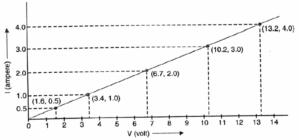
Resistance of the resistor, R = \(\frac{V_2-V_1}{I_2-I_1}\) = \(\frac{10.2-6.7}{3-2}\) = 3.5 Ω
Question 8. When a 12 V battery is connected across an unknown resistor, there is a current of 2.5 mA in the circuit. Find the value of the resistance of the resistor.
Given : V = 12 V, I = 2.5 mA = 2.5 x 10-3 A
Resistance, R = \(\frac{V}{I}=\frac{12}{2.5×10^{-3}}\) = 4800 Ω
Question 9. A battery of 9 V is connected in series with resistors of 0.2 Ω, 0.3 Ω, 0.4 Ω , 0.5 Ω and 12 Ω, respectively. How much current would flow through the 12 Ω resistor?
Total resistance, R = 0.2 + 0.3 + 0.4 + 0.5 + 12 = 13.4 Ω
Potential difference, V = 9 V
Current through the series circuit is I = V/R = 9/13.4 = 0.67 A
Current through 12 Ω resistor = 0.67 A.
Question 10. How many 176 Ω resistors (in parallel) are required to carry 5 A on a 220 V line?
Suppose n resistances of 176 Ω are connected in parallel. Then,
\(\frac{1}{R}=\frac{1}{176}+\frac{1}{176}+\)..... n factor = \(\frac{n}{176}\)
Or R = \(\frac{176}{n}\)
By Ohm's law, R = \(\frac{V}{I}\)
\(\frac{176}{n}\) = \(\frac{220}{5}\)
n = \(\frac{176×5}{220}\) = 4 resistors.
Question 11. Show how you would connect three resistors, each of resistance 6 Ω, so that the combination has a resistance of (i) 9 Ω, (ii) 4 Ω.
Here R1 = R2 = R3 = 6 n
(a) When we connect R1 in series with the parallel combination of R2 and R3, as shown in Fig. (a).

The equivalent resistance is
R = R1 + \(\frac{R_2×R_3}{R_2+R_3}\) = 6 + \(\frac{6×6}{6+6}\) = 6 + 3 = 9 Ω
(b) When we connect a series combination of R1 and R2 in parallel with R3, as shown
in Fig. (b), the equivalent resistance is
R = \(\frac{(R_1+R_2)×R_3}{R_1+R_2+R_3}\) = \(\frac{72}{18}\) = 4 Ω
Question 12. Several electric bulbs designed to be used on a 220 V electric supply line, are rated 10 W. How many lamps can be connected in parallel with each other across the two wires of 220 V line if the maximum allowable current is 5 A?
Resistance of each bulb, R = \(\frac{V^2}{P}\) = \(\frac{220^2}{10}\) = 4840 Ω
Suppose n bulbs are needed to be connected in parallel with each other. Then their equivalent resistance Rp is given by
\(\frac{1}{R_p}=\frac{1}{4840}+\frac{1}{4840}+\)..... n factor = \(\frac{n}{4840}\)
Or Rp = \(\frac{4840}{n}\) Ω
Given : V = 220 V, I = 5 A
By Ohm's law Rp = \(\frac{V}{I}\)
Or \(\frac{4840}{n}\) = \(\frac{220}{5}\)
n = \(\frac{4840×5}{220}\) = 110 lamps
Question 13. A hot plate of an electric oven connected to a 220 V line has two resistance coils A and B, each of 24 Ω resistance, which may be used separately, in series, or in parallel. What are the currents in the three cases?
(i) When the two coils A and B are used separately,
R = 24 Ω, V = 220 V
Current, I = \(\frac{V}{R}\) = \(\frac{220}{24}\) = 9.167 A.
(ii) When the two coils are connected in series,
R = 24 + 24 = 48 Ω, V = 220 V
Current, I = \(\frac{V}{R}\) = \(\frac{220}{48}\) = 4.58 A.
(iii) When the two coils are connected in parallel,
R = = 12 Ω, V = 220 V
Current, I = \(\frac{V}{R}\) = \(\frac{220}{12}\) = 18.33 A,
Question 14. Compare the power used in the 2 Ω resistor in each of the following circuits:
(i) a 6 V battery in series with 1 Ω and 2 Ω resistors, and
(ii) a 4 V battery in parallel with 12 Ω and 2 Ω resistors.
(i) The circuit shown in the fig has resistance connected in series combination:
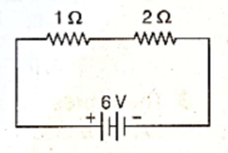
Current in the circuit, I = \(\frac{V}{R_1+R_2}\) = \(\frac{6}{1+2}\) = 2 A,
Power = I2R = 22 x 2 = 2 x 2 x 2 = 8 W
(ii) The circuit is shown in below fig has resistance connected in parallel combination.
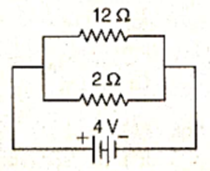
In parallel combination, potential across each resistor is same and equal to the potential applied to the circuit.
Potential across 2 Ω resistor, V = 4 V
Power = V2/R = 42/2 = 8 W
Power used in both the cases is same.
Question 15. Two lamps, one rated 100 W at 220 V, and the other 60 W at 220 V, are connected in parallel to electric mains supply. What current is drawn from the line if the supply voltage is 220 V?
Total power consumed in the circuit = 100 + 60 = 160 W
Voltage, V = 220 V,
Power = VI
∴ Current, I = Power/V = 160/220 = 0.727 A.
Question 16. Which uses more energy, a 250 W TV set in 1 hr, or a 1200 W toaster in 10 minutes?
Energy used by 250 W TV set in 1 hour = 250 W x 1 h = 250 W-h
Energy used by 1200 W toaster in 10 minutes
= 1200 W x 10 min = 1200 W x \(\frac{10}{60}\)h = 200 W-h
Thus, the TV set uses more energy than the toaster.
Question 17. An electric heater of resistance 8 Ω draws 15 A from the service mains 2 hours. Calculate the rate at which heat is developed in the heater.
Given: resistance, R = 8 Ω, current, I = 15 A
Time, t = 2 h = 7200 s
∴ Heat developed, H = I2Rt = (15 × 15 × 8 × 7200) J
∴ Rate of heat developed, P = \(\frac{H}{t}\) = \(\frac{15 × 15 × 8 × 7200}{7200}\) = 1800 W or 1800 J/s
Thus, the rate at which heat is developed in the heater is 1800 joule per second.
Question 18. Explain the following.
(a) Why is the tungsten used almost exclusively for filament of electric lamps?
(b) Why are the conductors of electric heating devices, such as bread-toasters and electric irons, made of an alloy rather than a pure metal?
(c) Why is the series arrangement not used for domestic circuits?
(d) How does the resistance of a wire vary with its area of cross-section?
(e) Why are copper and aluminium wires usually employed for electricity transmission?
(i) Tungsten has a high melting point (3380 ℃). It does not melt at high temperature. It retains as much of heat generated, so that it becomes very hot and emits light. That is the reason why tungsten is used as filament of electric lamps.
(ii) Conductors of electric heating devices are made of alloys because alloys do not oxidise (burn) readily at high temperature unlike metals. Also, alloys have a greater resistivity (generally) as compared to their constituent pure metals.
(iii) There are 2 reasons for not using series connections for domestic circuits.
- Devices of different current ratings cannot be connected as the current is constant in the series circuit.
- If one device fails, the circuit is broken and all devices stop working.
(iv) Resistance is inversely proportional to the area of cross-section of the wire. Thus, if the wire is thick (large area of cross-section), then resistance is less. If the wire is thin (less area of cross-section), then resistance is large.
(v) Copper and aluminium wires are used for transmission of electricity because they have low resistivity. So, they conduct the electric current without heavy heat losses. Also, they are quite cost effective, as compared to silver.
Click on below links to get PDF from store
PDF : Class 10th-Science-Chapter-11-Electricity-Notes
PDF : Class 10th-Science-Chapter-11-Electricity-Solution
Main Page : NCERT-Class-10-Science – All chapters notes, solutions, videos, test, pdf.
Previous Chapter : Chapter 10 : Human Eye and Colourful World – Online Notes
Next Chapter : Chapter-12-Magnetic Effects of Electric Current – Online Notes
